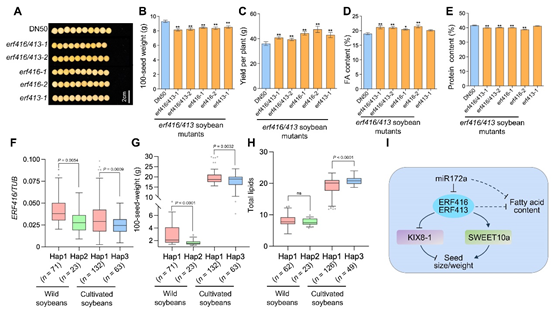Soybean (Glycine max) is a vital global source of plant protein and oil, used in food, feed, and industry. Boosting soybean yield is critical for food security and sustainable agriculture, yet the molecular mechanisms that shape seed size, weight, and composition are still not fully understood.
A team led by Prof. ZHANG Jinsong at the Institute of Genetics and Developmental Biology, Chinese Academy of Sciences, has uncovered a key genetic module that regulates soybean seed traits, offering new insights for crop improvement. Their study, published in Journal of Integrative Plant Biology (DOI:10.1111/jipb.70015) on August 14, 2025, reveals how miR172a and its target genes ERF416/413 influence seed size, weight, oil, and protein content.
MiR172a was found to have a direct impact on seed morphology and composition. Overexpression of MIR172a made seeds significantly smaller and lighter. It also altered fatty acid profiles, reducing palmitic, stearic, oleic, and linoleic acids while increasing linolenic acid, accompanied by a simultaneous rise in protein content.
Molecular experiments confirmed that miR172a triggers the cleavage of mRNAs from two target genes, ERF416 and ERF413. Gene editing experiments further clarified their roles: ERF416/413 mutants produced smaller seeds with reduced 100-seed weight, but surprisingly had up to 31.8% higher yield per plant and increased oil content (especially oleic acid), though protein levels declined. Conversely, overexpression of ERF416 led to bigger, heavier seeds (with up to 13% higher 100-seed weight), but unchanged total yield and decreased oil content.
The research also mapped the downstream regulatory pathways of ERF416/413, which directly bind to the promoters of other genes like GmKIX8-1 (involved in seed size control) and GmSWEET10a (responsible for sugar transport), thereby influencing seed development.
Analysis of 289 soybean accessions showed three major haplotypes of ERF416. Hap1 was linked to larger seeds but lower oil content, while Hap3 correlated with higher oil content—making Hap3 a promising allele for breeding high-oil soybean varieties.
“This work identifies the miR172a–ERF416/413 module as a central regulator of soybean seed development,” noted Prof. ZHANG. It provides valuable genetic resources and molecular targets for breeding soybeans with optimized yield and quality, balancing seed size, protein, and oil content.
Working model for the miR172a‐ERF416_ERF413 module in seed trait regulation in soybean (Image by IGDB)
Contact:
Prof. ZHANG Jinsong
Institute of Genetics and Developmental Biology, Chinese Academy of Sciences
Email: jszhang@genetics.ac.cn
 Working model for the miR172a‐ERF416_ERF413 module in seed trait regulation in soybean (Image by IGDB)Contact:Prof. ZHANG JinsongInstitute of Genetics and Developmental Biology, Chinese Academy of SciencesEmail: jszhang@genetics.ac.cn
Working model for the miR172a‐ERF416_ERF413 module in seed trait regulation in soybean (Image by IGDB)Contact:Prof. ZHANG JinsongInstitute of Genetics and Developmental Biology, Chinese Academy of SciencesEmail: jszhang@genetics.ac.cn CAS
CAS
 中文
中文




.png)
